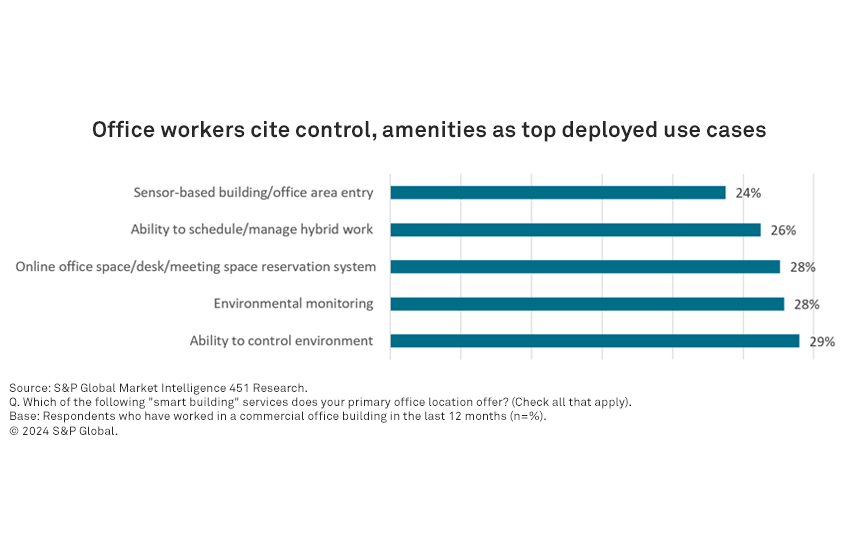
Source: tanoy1412/Technology via AdobeStock.
Recently, return-to-office policies have garnered significant attention as many of the largest companies in the U.S. reassess the flexibility of remote work. Although numerous organizations continue to implement hybrid models, the trend is shifting towards more employees spending increased time in physical office settings. However, the environments they return to may differ from those they previously occupied.
Context
The digital transformation of office environments is entering a new stage, influenced by evolving worker expectations in the post-COVID era. For nearly ten years, offices have utilized physical and Internet of Things (IoT) sensors to gain insights into employee behavior and to monitor and optimize resource use. In 2019, it became evident that as more devices were interconnected and data was collected and analyzed, knowledge workers started experiencing enhancements in their physical workspaces, increased support for flexible work models, and optimized mental performance.
Initial IoT applications in workspaces included supporting new work models, integrating augmented and virtual reality to boost collaboration, and facilitating real-time communication for field workers. Today, modern offices are leveraging the advanced capabilities of unified communications as a service and collaboration platforms, which are now extending into physical spaces. This allows for real-time insights into workspace availability and user behavior trends.
The intersection between the physical and digital realms
To some extent, almost all commercial buildings have invested in smart building technologies, focusing on three primary drivers: safety, sustainability, and occupant experience. In terms of safety, buildings have implemented video surveillance systems and are upgrading access control systems to be more cloud-based and adaptable, particularly in credential management. Sustainability is also a significant value driver for smart building initiatives, with many systems relying on or enhancing existing technologies such as energy management systems, building automation systems, and HVAC controls and optimizations. Although safety and sustainability receive the bulk of investment in building digitization, the occupant experience is increasingly important in contemporary commercial buildings.
According to data from a recent survey conducted by 451 Research, a part of S&P Global Market Intelligence, when asked about the smart building applications deployed at their primary office location, respondents indicated they were most familiar with technologies that enable them to control, enhance, and manage their physical environments.

Four out of the top five implemented use cases focus on improving the occupant experience and giving them more control over their environments. About one-third of respondents indicated that their office provides the capability to adjust their surroundings, such as lighting and temperature settings. Technologies for scheduling and managing hybrid work arrangements, which have been adopted by 26% of respondents, along with hot desking and reservation systems, used by 28%, are essential in today’s work environment as employees navigate time both in and out of the office.
Foreseeable obstacles and recommended best practices
Many return-to-office technologies depend on gathering and analyzing data about how employees or building occupants interact with their environments. For instance, knowing an employee’s typical arrival time can enable access management systems to integrate with elevator controls, reducing the need for the user to manually select their floor. Although this data is primarily intended to enhance operational efficiencies and improve the employee experience, there are potential challenges that need to be identified and managed to ensure successful implementation. Foreseeable obstacles and some approaches to each are as follows:
Refrain from using data for punitive purposes; instead, emphasize positive outcomes. The data gathered should aim to improve employee experience and productivity. By focusing data collection on benefits—such as optimizing workspace layouts according to occupancy patterns or adjusting lighting and temperature for comfort and efficiency—employees can enjoy a direct, positive impact from these technologies.
Prioritize privacy. Limit data collection to essential information and ensure it is anonymized, while clearly communicating to employees what data is being collected and the reasons behind it. To safeguard privacy, restrict access to personal or sensitive data through role-based controls, and encrypt data both when stored and during transmission. Conduct regular privacy audits to ensure all systems comply with current data governance policies.
Anticipate challenges when recruiting new candidates. Although a return to the office might be inevitable for certain industries, organizations will continue to face the repercussions of widespread remote work in their hiring processes for some time. This may result in losing top talent when candidates learn that remote work is not an option. According to survey respondents, the second most significant recruitment challenge for team managers is candidates expecting flexible work arrangements that the organization does not provide (34%). This issue slightly surpasses the challenge of candidates having high compensation expectations (32%).
Want insights on IoT trends delivered to your inbox? Join the 451 Alliance.
Want insights on consumer technology trends delivered to your inbox? Join the 451 Alliance.
This content may be AI-assisted and is composed, reviewed, edited and approved by S&P Global in accordance with our Terms of Service.

